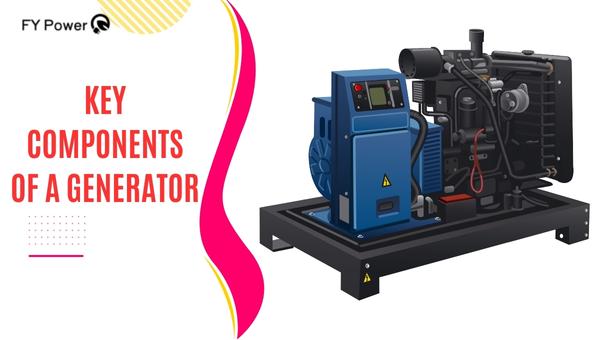Imagine a world plunged into darkness, your home devoid of power, and the only savior is your trusty generator that hasn’t been maintained in ages. The nightmare scenario, right? Well, you’re not alone. Many folks neglect regular generator maintenance until it’s too late.
However, tuning up your generator doesn’t have to be an arduous task. It’s about understanding your machine, taking safety measures before diving in, following a comprehensive step-by-step guide for the tune-up process, and knowing what to do post-maintenance.
We’ve prepared this detailed yet easy-to-follow guide on how to tune up your generator effortlessly with handy maintenance tips and more. Let’s make sure you’re never left powerless when you need it most!
So sit back, relax, and let us take you through the journey of prolonging the life of your faithful energetic companion. After all, we’re all part of the same community where power disruptions should be kept at bay!
Key Takeaways
- Regular maintenance is crucial for the longevity and peak performance of your generator.
- Understanding your generator’s type and specific needs is important for effective maintenance.
- Safety precautions, such as wearing safety gear and creating a safe work environment, are essential during generator maintenance.
- Proper cleaning, oil changes, filter replacements, and fuel system checks are key maintenance tasks for optimal generator performance.

Importance of Regular Generator Maintenance
You might not realize it, but keeping up with regular maintenance on your generator is crucial – it’s the secret to ensuring its longevity and peak performance. With frequent use, your generator can experience wear and tear, leading to reduced efficiency. Regular tune-ups help prevent such minor issues from escalating into costly repairs or even replacements.
When you maintain your generator regularly, you keep the maintenance costs down. Minor fixes are usually inexpensive compared to major repairs that may arise due to neglect. If potential problems are caught early enough during routine checkups, they can be addressed immediately, thereby saving you from exorbitant repair bills in the future.
Another vital aspect of regular maintenance lies in preserving your warranty coverage. Many manufacturers require evidence of regular professional servicing as a prerequisite for honoring warranties. Failure to adhere to these conditions could void your warranty and leave you shouldering any repair costs alone.
Professional servicing also guarantees that all parts of your generator are working correctly, enhancing its general output quality and reliability during those times when you need it most. A well-maintained generator will provide a consistent power supply without unexpected breakdowns, leaving you in the dark or disrupting essential operations.
Also Read: Why My Generator Is Not Starting? 9 Reasons With Solution
Overview of Tuning Up Process
Think of the tuning-up process as a physical check-up for your generator, ensuring it’s in tip-top shape when you need its power the most. It’s about more than just extending your generator lifespan; it’s also about optimizing tuning efficiency and minimizing maintenance costs in the long run. The key is to be proactive, not reactive; taking action before problems arise can save you time, energy, and money down the line.
Now let’s dive into what this tune-up might look like:
- Inspection: Begin with an overall visual inspection of your generator. Are there any visible signs of wear or damage? Pay particular attention to parts like the alternator and cooling system.
- Cleaning: Dirt and debris can reduce your generator’s efficiency considerably over time, so cleaning is essential. This includes removing dust from air filters and oiling necessary components.
- Replacement or Repair: Some parts may need replacement or repair based on your inspection findings. Always prioritize replacing worn-out parts for better performance.
Remember that every single component within your machine plays a vital role in its overall functionality – neglect one part, and you risk compromising the whole system.
Tuning up isn’t just about prolonging your machine’s life – it’s about maintaining that sense of security we all crave when it comes to our power supply needs. By caring for your equipment now, you’re ensuring that when you flick that switch during a power outage – whether tomorrow or five years from now – you’ll know with certainty that light will follow because you’ve done everything possible to ensure reliability through regular tune-ups.
Understanding Your Generator
Understanding your generator isn’t just about knowing how to switch it on and off. It’s about recognizing the different types of generators and understanding the key components that make them function.
It’s also important to get familiar with your specific model through its manual. Armed with this knowledge, you’ll be able to operate your generator more efficiently and potentially troubleshoot minor issues before they become major problems.
Different Types of Generators
Before diving into maintenance tips, it’s crucial to know there are various types of generators, each with its unique needs.
From fuel choices to power output and portability, your chosen generator plays a key role in its care and upkeep.
Firstly, consider the Generator Fuels. Some units run on gasoline, others on propane or diesel – even solar energy is an option. Each fuel type has different implications for maintenance and performance.
Next, think about Power Output. Smaller generators typically produce less power but may be easier to maintain than larger, more powerful models.
Lastly, the Portable vs. Standby debate: portable generators require regular checks due to their mobility, while standby units are permanently installed and demand periodic professional servicing.
Knowing your generator’s specifics will help you tune it up effectively and prolong its lifespan.
Also Read: How Does An Inverter Generator Work? Pros and Cons Included
Key Components of a Generator
When it comes to the nuts and bolts of your generator, you’re dealing with several key components that are essential for its operation. Each part plays a vital role in ensuring optimal power output and maximizing your generator’s lifespan.

- Engine: This is the heart of your generator. It converts fuel into mechanical energy, driving the alternator for electricity production.
- Alternator: Often known as the ‘Genhead’, it transforms mechanical energy from the engine into electrical energy.
- Fuel System: Crucial for powering the engine, this system includes elements like a fuel tank and carburetor.
- Voltage Regulator: This maintains an even voltage level, enhancing generator efficiency.
Understanding these core components helps foster a sense of belonging within our community of generator owners who share common goals: efficient performance and long-lasting equipment life.
Understanding Your Generator’s Manual
Diving into the details of your generator’s manual may seem daunting, yet it’s an invaluable tool for getting to grips with your machine. This isn’t just a booklet filled with technical jargon but a guide to understanding and maintaining your generator effectively.
Manual Interpretation is crucial in this process. It helps you decode complex instructions, making User Troubleshooting a breeze. Need to figure out why the engine won’t start or how to replace the oil filter? The answers are all there in your manual.
Always keep an eye out for Manual Updates too. Manufacturers often release new information about their products that can be essential for optimal performance. Remember, mastering your generator’s manual is key to ensuring its longevity and smooth operation.
Pre-Maintenance Safety Measures
Before you delve into tuning up your generator, it’s vital to consider some precautionary steps for your safety.
Don’t overlook the importance of wearing essential safety gear like gloves and eye protection while working.
Additionally, ensuring a safe and clutter-free work environment is crucial to minimize potential hazards during the maintenance process.
Precautionary Steps Before Tuning Up
Just like you wouldn’t start cooking without first washing your hands, taking certain precautionary steps is crucial before tuning up your generator.
Proper generator placement is key; set it in a well-ventilated area, away from combustible materials. We’re all part of the same community here, and safety should be our shared priority.
Handling fuel deserves careful attention too. Always ensure that the generator is cool before refueling to prevent any fire hazards. Remember, we’re in this together; helping each other stay safe matters!
Lastly, before diving into maintenance tasks, troubleshoot for any issues. Listen for unusual noises or look for leaks. Being proactive prevents potential problems down the line. Let’s keep our gear running smoothly and safely as a team!
Also Read: Inverter Generator vs Traditional Generator: Which Is Best?
Essential Safety Gear
Don’t skimp on safety gear when working with generators; it’s not just about protecting the machine but safeguarding you too. Being equipped with the right safety gear types is paramount to your well-being.
- Safety Glasses: Protect your eyes from sparks or debris. Always keep them clean using proper gear cleaning tips, such as wiping them with a soft cloth. Avoid abrasive materials that could scratch and reduce their effectiveness. Replace them if they become too scratched or damaged to ensure optimal protection throughout their gear lifespan.
- Gloves: Insulated ones are best for handling hot parts and preventing electric shocks. Regularly inspect gloves for tears or wear.
- Noise-Canceling Headphones: Generators can be loud; these protect your hearing while allowing you to work comfortably.
Remember, safety is an investment that pays off every time you tune up your generator.
Importance of a Safe Working Environment
You’ll discover that creating a safe working environment isn’t only crucial, it’s also easier than you might think.
This involves more than just wearing the right safety gear; it encompasses everything from workplace ergonomics to emergency preparedness.
Proper placement and handling of your generator can drastically reduce the risk of accidents and improve everyone’s overall comfort.
Understanding accident prevention is paramount. Following maintenance instructions, avoiding overloading, and maintaining good ventilation are all part of this.
Regular checks for wear and tear or any unusual sounds can prevent mishaps before they occur.
Emergency preparedness is equally vital. Knowing what to do in case something goes wrong gives you confidence and peace of mind.
So remember, a safe working environment isn’t just about safety—it’s about belonging to a culture where everyone’s well-being matters.
Also Read: 10+ Tips To Choose The Best Generator For Construction Sites
Step-by-Step Guide to Tune Up Your Generator
Ready to give your generator the servicing it needs? This comprehensive guide will walk you through each step, starting from cleaning your generator, checking and changing its oil, to examining and replacing air filters.

We’ll also help you understand how to check and replace spark plugs and assess the fuel system for a well-rounded maintenance routine that keeps your generator running smoothly.
Cleaning Your Generator
As a generator owner, it’s essential that you’re well-versed in the necessary techniques to keep your machine running smoothly and efficiently.
This includes understanding how to clean both the exterior and interior of your generator properly.
We’ll guide you through these processes, offering expert advice on effective methods for general maintenance, ensuring your generator remains in top-notch condition for years to come.
Exterior Cleaning
Keeping your generator’s exterior clean isn’t just about aesthetics, it can also extend its lifespan. In a 2019 report by a leading manufacturer, generators that were regularly wiped down and kept dirt-free had notably fewer technical issues compared to those left uncared for.
Here’s how you can maintain yours:
- Use pressure washing for deep cleaning
- Apply rust prevention methods
- Invest in paint protection
- Regularly remove dust and debris
Remember, a little effort now means less trouble later!
Interior Cleaning
Don’t overlook the importance of your generator’s interior when it comes to cleaning and care. Dust accumulation impacts its performance, leading to potential breakdowns. Regularly clean the interior for corrosion prevention and optimal functionality.
Remember, a well-cared-for machine is less likely to attract pests. By taking these steps, you ensure you’re part of a community that values preventive maintenance and longevity in their equipment.
Also Read: Changing Oil in Generator: A Simple Step-By-Step Guide
Checking and Changing the Oil
You’ll want to make sure your generator’s oil is in top shape, so let’s dive into how to check and change it effectively.
First off, you should understand oil quality indicators. A dark, thick consistency or a low level can signal the need for an oil change.
Choosing between synthetic and conventional oil is another important decision. Synthetic oils are generally more resistant to heat and may extend your generator’s lifespan. However, they’re also pricier.
When changing the oil, make sure you have a container for recycling used oil at hand. Environmentally-friendly disposal is a must in our shared effort to protect the planet.
With regular check-ups and timely changes, your generator will perform optimally when you need it most.
You’re part of this essential maintenance community now – welcome aboard!
Checking and Replacing Air Filters
Just as with your car, your generator’s air filters need regular attention to ensure optimal performance. The role of an air filter is crucial in maintaining airflow optimization and protecting the engine from harmful debris.
Here are four simple steps to check and replace your generator’s air filter:
- Inspect Regularly: Look for any signs of damage or excessive dirt on the filter.
- Choose the Right Material: Filter material choices can impact performance. Choose a high-quality, durable filter that fits your specific model.
- Clean or Replace: Depending on its condition, clean the filter or replace it entirely.
- Seasonal Adjustments: Depending on usage and weather conditions, you may need to change filters more frequently during certain seasons.
By following these guidelines, you’ll help ensure your generator runs smoothly when you need it most.
Checking and Replacing Spark Plugs
Now that we’ve sorted your air filters let’s shift our focus to another crucial component: the spark plugs. Much like the human heart, they’re responsible for igniting life into your generator.
The first step is identifying which of the various spark plug types your generator uses. Once you know that, it becomes easier to diagnose potential issues and begin ignition troubleshooting. A faulty spark plug could be the culprit if your generator isn’t starting or running smoothly.
Inspecting and replacing spark plugs regularly will ensure optimal performance. While doing so, don’t neglect the plug wires; these, too, may require replacement over time. Taking care of this intricate system will make you feel like a valued part of our community, dedicated to maintaining power when most needed.
Checking the Fuel System
After tending to your spark plugs, it’s time to peer into the lifeblood of your generator: the fuel system. This part of your equipment plays a vital role in its operation and deserves close attention.
The quality of fuel you use can significantly impact the efficiency and longevity of your generator. Therefore, ensure that you’re using high-quality fuel void of any contaminants.
Part of maintaining a healthy fuel system is knowing how to detect fuel leakage. A simple yet effective method includes inspecting for visible signs, such as pools or stains, near the base of your generator. Regular checks for leaks will help keep things running smoothly.
Lastly, consider investing in upgrades that enhance performance and extend the lifespan of your fuel system. These investments foster a sense of belonging as they assure you’ve made steps towards long-term reliability and effectiveness.
Battery Maintenance
Ensuring the generator’s battery is in tip-top shape can be likened to safeguarding a beating heart, which is vital for the life of your machine.
To extend your battery lifespan, regular check-ups are key. Familiarize yourself with different battery types and their respective maintenance requirements.
Lead-acid batteries, for instance, require distilled water top-ups, while absorbed glass mat (AGM) batteries are virtually maintenance-free but costlier.
Knowledge is power here; understanding these nuances ensures you’re part of a community that values informed decision-making.
Consider eco-friendly options too. Solar-powered batteries might suit your needs, reducing carbon emissions and ongoing costs associated with traditional options.
Battery care isn’t just about preserving an appliance; it’s about participating in a larger effort of environmental stewardship and resource conservation while ensuring reliable performance from your generator.
Testing the Generator
Testing the generator is crucial. It’s important to put your generator through its paces regularly, just like you would with a trusty steed before a long journey. Testing is an integral part of generator maintenance. It helps in troubleshooting any potential issues down the road.
Here are some reasons why regular testing is important:
- Generator Troubleshooting: Regular tests can help identify any operational glitches early on. If the generator doesn’t start or run smoothly, it’s time to delve into deeper diagnostics.
- Fuel Efficiency: Regular testing ensures optimal fuel use. An inefficiently running generator guzzles more fuel than necessary, increasing your costs.
- Noise Reduction: A well-maintained, properly functioning generator operates at low noise levels, enhancing your comfort level.
Remember, inclusivity is key in our community. We aim to empower each other with knowledge for better self-reliance and peace of mind!
Also Read: Who Makes Champion Generators, Where Are They Made?
Post-Maintenance Steps
Now that you’ve successfully tuned up your generator let’s explore the next critical steps for its longevity – proper storage and a regular maintenance schedule.
Understanding how crucial it is to store your generator correctly when not in use and adhere religiously to a maintenance routine is essential. This will ensure that your machine remains in top condition, ready to provide power whenever you need it.
Properly Storing Your Generator
Believe it or not, about 50% of generator failures can be attributed to improper storage and maintenance. You can avoid this by giving your generator the care it deserves during its downtime.
Start with a quality generator cover, which protects against dust, moisture, and other elements that could damage its components.
Before you tuck your machine away for seasonal storage, fill the tank with fresh fuel and add a fuel stabilizer. This prevents the gas from deteriorating and causing harm to your engine. Additionally, running the generator for a few minutes allows the stabilized fuel to circulate throughout the system.
Remember, proper storage isn’t just about preserving equipment; it’s also about ensuring you’re part of a community that values preparedness and reliability.
Regular Maintenance Schedule
Don’t underestimate the power of a regular upkeep schedule for your generator. This simple habit can make all the difference between being left in the dark during an emergency or having a reliable source of backup power.
Scheduled inspections are key to ensuring its long-term performance. By incorporating preventative measures such as oil changes, filter replacements, and general cleanups in your routine checks, you’re investing not only in uninterrupted power supply but also in reducing hefty upkeep costs down the line.
Establishing this discipline fosters a sense of belonging with your equipment – you’re not just an owner but a caretaker too. So stay ahead by keeping up with maintenance tasks, knowing that your generator will always be ready when you need it most.
Frequently Asked Questions
What are some common issues I might encounter when using my generator?
You may face generator overheating, oil leaks, or starting difficulties. Overheating can harm internal parts, while oil leaks pose a fire risk. Starting issues indicate potential mechanical problems requiring professional attention.
How much does it typically cost to get a professional to tune up my generator?
Cost comparison varies, but professional generator tune-ups typically range from $150 to $300. Your investment in professional expertise reaps significant tune-up benefits like enhanced performance and longer equipment lifespan.
How often should I replace the generator’s fuel filter?
Your generator’s fuel filter lifespan varies, but replacing it every 100-200 hours of use is generally wise. Understand the replacement steps and fuel filter types to ensure a seamless maintenance process.
Can I still use my generator if it has not been tuned up for an extended period?
Yes, you can still use your generator. However, neglected maintenance might shorten its lifespan and compromise usage safety. Regular tune-ups ensure optimal performance and longevity of your generator, fostering a sense of security.
Are there specific brands of generators that are easier to maintain and tune up?
Statistically, Honda and Yamaha’s generators require less frequent maintenance. Brand comparisons show these models promote generator longevity due to their high-quality build, making them ideal for those seeking a long-term power solution.
Conclusion
You’ve done it! Now you’re not only aware of the importance of regular generator maintenance but also proficient in tuning up your own unit. Remember, 85% of generator failures are caused by neglecting regular maintenance.
So, keep up with your routine check-ups to ensure a long-lasting and efficient machine. It’s surprisingly easy once you get the hang of it. Here’s to uninterrupted power – all thanks to your diligence and newfound skill set!

